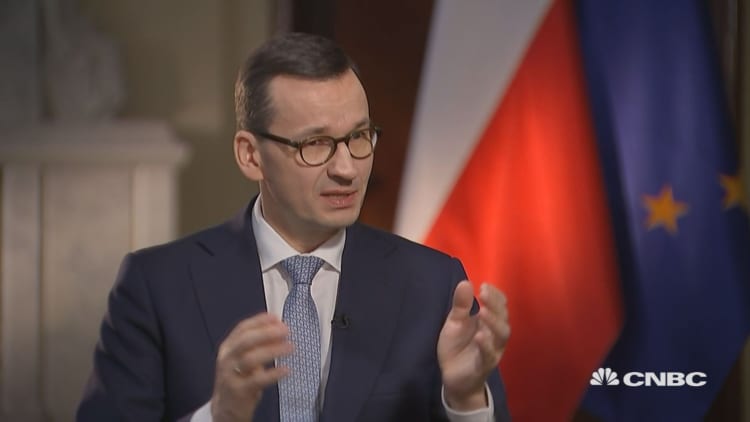Depending on who you ask, Nord Stream 2 is either a sustainable way to ensure European energy security or a proxy for Russian hybrid warfare.
With construction underway and as Germany attempts to downplay criticism of the project, concerns over security and geopolitics remain.
United States Energy Secretary Rick Perry said Tuesday that a sanctions bill putting restrictions on companies involved in the project would come in the "not too distant future."
What is Nord Stream 2?
Nord Stream 2 is a pipeline currently under construction from Russia to Germany via the Baltic Sea. The new pipeline will run alongside the already constructed Nord Stream and will double the amount of gas being funneled through the Baltics to 110 billion cubic meters per year.
Estimated to become operational in early 2020, the pipeline is intended to provide Europe with a sustainable gas supply while providing Russia with more direct access to the European gas market. But as tensions between Russia and the West reach their highest in decades, many are skeptical of the purely economic reasoning attributed to the project.
German dependence
Germany finds itself in a precarious position. Oil and gas are the lifeblood of Germany's manufacturing economy, but the country produces very little energy domestically and is dependent on imports for 98% of its oil and 92% of its gas supply. As of 2015, Russia already supplied the plurality of its oil and gas (40% and 35% respectively), so it was with no great surprise that plans to increase Russia's presence were met with hostility on both sides of the Atlantic.
The core concern centers around Germany's dependence on Russian energy which could make it susceptible to exploitation and more vulnerable to interference.
In an interview with CNBC's Brian Sullivan in March, Perry spoke on behalf of the United States when warning that "Russian gas has strings attached." In fact, U.S. Congress and the European Parliament passed resolutions calling for an end to construction of the pipeline, citing Russian dependence as a threat to the common market and the EU's strategic interests.
Germany, Europe's biggest natural gas consumer, has made efforts to downplay the relevance of Russian energy on the nation's security. German Defense Minister Ursula von der Leyen has previously told CNBC that the country is not too concerned over security risks, arguing that it will sufficiently diversify their imports.
Ukrainian isolation
Since gaining its independence at the end of the Cold War, Ukraine has been Russia's gatekeeper to the European gas market. As of 2017, some 40% of Europe's total gas supply was fed by Russian companies through Ukrainian soil, with transit fees providing Kiev with roughly $2 billion to $3 billion annually.
This "middle-man" status provides Ukraine with substantial geopolitical leverage, so attempts to bypass the ex-soviet state with this new pipeline in the Baltic Sea have raised alarm bells.
Many fear that Russia is deliberately attempting to weaken the country for its own strategic advantage. Ending gas transit could reduce Ukraine's GDP (gross domestic product) by up to 3%. Meanwhile, the annexation of Crimea in 2014 provides a stark reminder as to the potential consequences of isolation from Europe.
While German Chancellor Angela Merkel and others have insisted that gas must continue to flow through Ukraine, no arrangements have been made and Russia remains unreserved about its intentions to restrict gas supplies once the new pipeline is complete. Speaking to Russian television in April 2018, the CEO of Russian oil giant Gazprom revealed that gas will continue to flow via Ukraine, "but the volumes of such transit will be much lower, probably, 10 to 15 billion cubic meters a year." That's just 15% of the gas currently in transit, and this comes amid speculation that Russia intends to eventually reduce this number to zero.
As it stands, Nord Stream 2 is to become operational in early 2020, just after the current contract expires between Ukrainian and Russian-owned energy giants, Naftogaz and Gazprom.

Nordic security
The 1,200 kilometer pipeline travels from Russia to Germany, but its proposed route enters the territorial waters and EEZ (Exclusive Economic Zone) of three other countries: Finland, Sweden and Denmark.
National governments and local authorities are set to benefit economically from investment and employment in the pipeline, but politicians and military experts have raised issues related to European security. Namely that plans to allow Nord Stream workers to use Swedish ports, including their main navy base in Karlskrona, could provide Russia with an opportunity to gain intelligence and plot espionage activities.
Experts including Polish Foreign Minister Jacek Czaputowicz have warned that the pipeline gives Russia the pretext to increase their military presence in the Baltic Sea, even using it as a means to transmit military information on the movements of naval vessels.
Despite these concerns, Denmark remains the only country yet to approve construction through its waters. On March 25, Danish authorities requested alternative routes be investigated as the country mulls over the decision. Yet even if the Danish were to reject construction in its territory, the pipeline would simply be altered to pass through international waters. In other words, Danish refusal would only delay the project, not kill it entirely.

